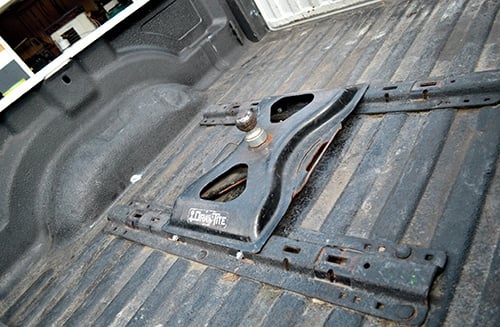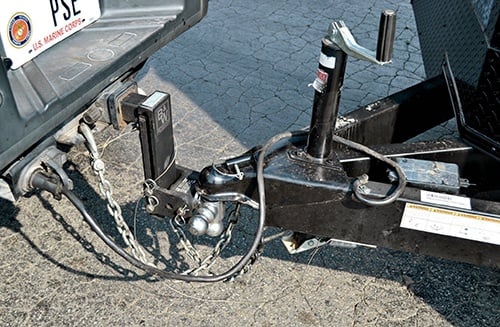How to Choose the Right Horse Trailer Hitch Ball Size

Here is a quick guide to everything you should know about choosing the right hitch ball size for your horse trailer.
Hitching a Horse Trailer 101
Before we get into the nitty gritty of ball sizes, let’s review the basics of hitching a horse trailer. The very first step is for you to take a critical look at your tow vehicle to make sure it is well matched to your horse trailer. Check out the weight and tongue weight of your horse trailer and compare that to your tow vehicle’s towing capacity and the tongue weight capacity on your hitch.
It helps if you are familiar with the basic parts connecting your tow vehicle and horse trailer. The hitch on the back of your tow vehicle has three main parts: receiver, ball mount, and the ball. This round ball can vary in size from 1 7/8” up to 2 5/16” in diameter.
Then, your horse trailer has a coupler, safety chains/cables, a wiring harness, and an emergency breakaway system. Again, the coupler can vary in size depending on the size of the trailer.
The ball and the coupler are the two parts we’ll focus on today. The coupler is like a steel glove that fits around the ball to hold the trailer and the tow vehicle together. If the two parts are not a good size match, they will not make a secure connection.
Why is the Proper Hitch Ball Size Important?
Brad Heath, owner of Double D Trailers, says that it’s not uncommon for people to use the wrong size ball when towing. “I’ve had more than one customer contact me over the years to tell me their trailer came off the ball before it left their driveway. Often, they claim they have a defective coupler. Usually, they just have the wrong ball size or did not secure the coupler correctly.”
If the hitch ball size is correct and the coupler is properly connected, it’s impossible for the two to become disconnected unless the coupler actually breaks. This would only happen if the trailer was severely overloaded beyond the maximum stated capacity.
For example, if your trailer has a larger 2 5/16” coupler and your tow vehicle only has a 1 7/8” or 2” ball, there is a serious risk of disconnect during travel. The coupler is like a claw and it cannot get a good grip on the outside of a ball that is too small. Any bump in the road will pop the coupler off of the smaller ball.
What are Typical Coupler and Ball Sizes in the United States?

For bumper pull horse trailers, the size of the coupler is going to vary based on the weight being carried. A smaller trailer can get away with a smaller coupler and ball size. Common choices are going to be 1 7/8”, 2”, and 2 5/16”.
Smaller trailer such as utility or boat trailers may have a 1 7/8” coupler/ball requirement. Larger trailers such as flatbeds or horse trailers will have a 2” or 2 5/16” coupler depending on how it’s being used. All Double D Trailers (big or small) have a 2 5/16” coupler and ball size as it has the highest rating.
If you’ve been hauling your boat around for years, don’t assume the same hitch and ball will work for your horse trailer. There’s a good chance you’ll need a larger ball to handle the additional weight of live animals behind you.
A Closer Look at Horse Trailer Couplers
Another thing that will vary with your trailer type is the actual design of the trailer’s coupler. All gooseneck horse trailers have the same coupler and connect to a hitch ball mounted in the back of a pick-up truck.
But with bumper pull trailers, there are many options for trailer manufacturers to use at the time of manufacturing. The size of the coupler should be determined by the weight being carried. For example, this coupler manufacturer offers multiple couplers with varying ball sizes and weight capacities ranging from 7,000 to 15,000 pounds.
Bumper pull trailers also have different styles of couplers including three options: A-Frame, Straight, or Adjustable. The style of coupler will be determined by the manufacturer and vary in cost, capacity, and how they actually latch onto the ball. Double D Trailers have A-Frame couplers.
The style of the coupler is going to determine how your trailer latches onto your tow vehicle’s ball. Some styles are easier to operate than others. For example, the Bulldog hitch linked above has a sliding color while other trailers have a latch on top, which Brad feels is easier to operate.
How to Make Sure Your Ball and Coupler are Well Matched
Before you take possession of a new trailer, be sure you know how to properly latch the coupler onto your hitch ball. Also, double check the size of the trailer’s coupler so you can be sure your tow vehicle’s hitch ball is the correct size.
If you have a hitched used to tow a small utility trailer or boat, there is a good chance you’ll need to get a larger hitch ball to use with your horse trailer. Always double check your connection and make sure the ball is securely held in the coupler. Then, if you’re going on a long trip, pop back periodically to check your hitch connection, safety chains, and wiring harness.
For any additional questions about hitching your horse trailer, feel free to contact Brad.



